7 books about Tamil Nadu
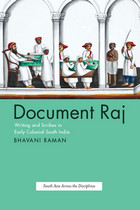
Document Raj
Writing and Scribes in Early Colonial South India
Bhavani Raman
University of Chicago Press, 2012
Historians of British colonial rule in India have noted both the place of military might and the imposition of new cultural categories in the making of Empire, but Bhavani Raman, in Document Raj, uncovers a lesser-known story of power: the power of bureaucracy. Drawing on extensive archival research in the files of the East India Company’s administrative offices in Madras, she tells the story of a bureaucracy gone awry in a fever of documentation practices that grew ever more abstract—and the power, both economic and cultural, this created.
In order to assert its legitimacy and value within the British Empire, the East India Company was diligent about record keeping. Raman shows, however, that the sheer volume of their document production allowed colonial managers to subtly but substantively manipulate records for their own ends, increasingly drawing the real and the recorded further apart. While this administrative sleight of hand increased the company’s reach and power within the Empire, it also bolstered profoundly new orientations to language, writing, memory, and pedagogy for the officers and Indian subordinates involved. Immersed in a subterranean world of delinquent scribes, translators, village accountants, and entrepreneurial fixers, Document Raj maps the shifting boundaries of the legible and illegible, the legal and illegitimate, that would usher India into the modern world.
[more]
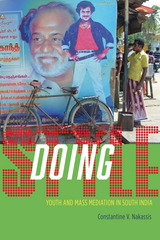
Doing Style
Youth and Mass Mediation in South India
Constantine V. Nakassis
University of Chicago Press, 2016
In Doing Style, Constantine V. Nakassis explores the world of youth and mass media in South India, where what Tamil youth call “style” anchors their day-to-day lives and media worlds. Through intimate ethnographic descriptions of college life in Tamil Nadu, Nakassis explores the complex ways that acts and objects of style such as brand fashion, English slang, and film representations express the multiple desires and anxieties of this generation, who live in the shadow of the promise of global modernity.
As Nakassis shows, while signs of the global, modern world are everywhere in post-liberalization India, for most of these young people this world is still very distant—a paradox that results in youth’s profound sense of being in between. This in-betweenness manifests itself in the ambivalent quality of style, the ways in which stylish objects are necessarily marked as counterfeit, mixed, or ironical. In order to show how this in-betweenness materializes in particular media, Nakassis explores the entanglements between youth peer groups and the sites where such stylish media objects are produced, arguing that these entanglements deeply condition the production and circulation of the media objects themselves. The result is an important and timely look at the tremendous forces of youth culture, globalization, and mass media as they interact in the vibrancy of a rapidly changing India.
As Nakassis shows, while signs of the global, modern world are everywhere in post-liberalization India, for most of these young people this world is still very distant—a paradox that results in youth’s profound sense of being in between. This in-betweenness manifests itself in the ambivalent quality of style, the ways in which stylish objects are necessarily marked as counterfeit, mixed, or ironical. In order to show how this in-betweenness materializes in particular media, Nakassis explores the entanglements between youth peer groups and the sites where such stylish media objects are produced, arguing that these entanglements deeply condition the production and circulation of the media objects themselves. The result is an important and timely look at the tremendous forces of youth culture, globalization, and mass media as they interact in the vibrancy of a rapidly changing India.
[more]
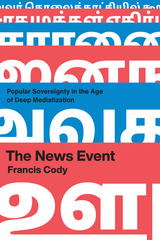
The News Event
Popular Sovereignty in the Age of Deep Mediatization
Francis Cody
University of Chicago Press, 2023
In the hypermediated world of Tamil Nadu, Francis Cody studies how “news events” are made.
Not merely the act of representing events with words or images, a “news event” is the reciprocal relationship between the events being reported in the news and the event of the news coverage itself. In The News Event, Francis Cody focuses on how imaginaries of popular sovereignty have been remade through the production and experience of such events. Political sovereignty is thoroughly mediated by the production of news, and subjects invested in the idea of democracy are remarkably reflexive about the role of publicly circulating images and texts in the very constitution of their subjectivity. The law comes to stand as both a limit and positive condition in this process of event making, where acts of legal and extralegal repression of publication can also become the stuff of news about news makers. When the subjects of news inhabit multiple participant roles in the unfolding of public events, when the very technologies of recording and circulating events themselves become news, the act of representing a political event becomes difficult to disentangle from that of participating in it. This, Cody argues, is the crisis of contemporary news making: the news can no longer claim exteriority to the world on which it reports.
Not merely the act of representing events with words or images, a “news event” is the reciprocal relationship between the events being reported in the news and the event of the news coverage itself. In The News Event, Francis Cody focuses on how imaginaries of popular sovereignty have been remade through the production and experience of such events. Political sovereignty is thoroughly mediated by the production of news, and subjects invested in the idea of democracy are remarkably reflexive about the role of publicly circulating images and texts in the very constitution of their subjectivity. The law comes to stand as both a limit and positive condition in this process of event making, where acts of legal and extralegal repression of publication can also become the stuff of news about news makers. When the subjects of news inhabit multiple participant roles in the unfolding of public events, when the very technologies of recording and circulating events themselves become news, the act of representing a political event becomes difficult to disentangle from that of participating in it. This, Cody argues, is the crisis of contemporary news making: the news can no longer claim exteriority to the world on which it reports.
[more]
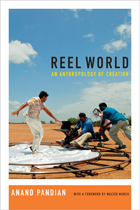
Reel World
An Anthropology of Creation
Anand Pandian
Duke University Press, 2015
Reel World explores what happens to life when everything begins to look and feel like cinema. Drawing on years of fieldwork with Tamil filmmakers, artists, musicians, and craftsmen in the south Indian movie studios of "Kollywood," Anand Pandian examines how ordinary moments become elements of a cinematic world. With inventive, experimental, and sometimes comical zeal, Pandian pursues the sensory richness of cinematic experience and the adventure of a writing true to these sensations. Thinking with the visceral power of sound and image, his stories also broach deeply philosophical themes such as desire, time, wonder, and imagination. In a spirit devoted to the turbulence and uncertainty of genesis, Reel World brings into focus an ecology of creative process: the many forces, feelings, beings, and things that infuse human endeavors with transformative potential.
[more]
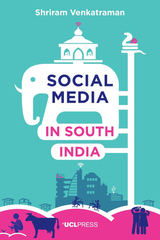
Social Media in South India
Shriram Venkatraman
University College London, 2017
This book is one of the first ethnographic studies to explore the use of social media in the everyday lives of people in Tamil Nadu, a region of South India experiencing rapid change. In the past decade, there has been an influx of IT companies into a space once dominated by agriculture, resulting in a complex juxtaposition between an evolving knowledge economy and the traditions of rural life. This study suggests there is a blurring of boundaries and asserts that the use of various social media platforms in the region, while seeming to induce societal change, also remain bound by local practices influenced by class, age, gender, and caste.
[more]
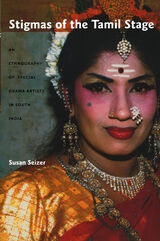
Stigmas of the Tamil Stage
An Ethnography of Special Drama Artists in South India
Susan Seizer
Duke University Press, 2005
A study of the lives of popular theater artists, Stigmas of the Tamil Stage is the first in-depth analysis of Special Drama, a genre of performance unique to the southernmost Indian state of Tamilnadu. Held in towns and villages throughout the region, Special Drama performances last from 10 p.m. until dawn. There are no theatrical troupes in Special Drama; individual artists are contracted “specially” for each event. The first two hours of each performance are filled with the kind of bawdy, improvisational comedy that is the primary focus of this study; the remaining hours present more markedly staid dramatic treatments of myth and history. Special Drama artists themselves are of all ages, castes, and ethnic and religious affiliations; the one common denominator in their lives is their lower-class status. Artists regularly speak of how poverty compelled their entrance into the field.
Special Drama is looked down upon by the middle- and upper-classes as too popular, too vulgar, and too “mixed.” The artists are stigmatized: people insult them in public and landlords refuse to rent to them. Stigma falls most heavily, however, on actresses, who are marked as “public women” by their participation in Special Drama. As Susan Seizer’s sensitive study shows, one of the primary ways the performers deal with such stigma is through humor and linguistic play. Their comedic performances in particular directly address questions of class, culture, and gender deviations—the very issues that so stigmatize them. Seizer draws on extensive interviews with performers, sponsors, audience members, and drama agents as well as on careful readings of live Special Drama performances in considering the complexities of performers’ lives both on stage and off.
Special Drama is looked down upon by the middle- and upper-classes as too popular, too vulgar, and too “mixed.” The artists are stigmatized: people insult them in public and landlords refuse to rent to them. Stigma falls most heavily, however, on actresses, who are marked as “public women” by their participation in Special Drama. As Susan Seizer’s sensitive study shows, one of the primary ways the performers deal with such stigma is through humor and linguistic play. Their comedic performances in particular directly address questions of class, culture, and gender deviations—the very issues that so stigmatize them. Seizer draws on extensive interviews with performers, sponsors, audience members, and drama agents as well as on careful readings of live Special Drama performances in considering the complexities of performers’ lives both on stage and off.
[more]
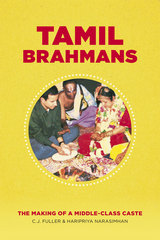
Tamil Brahmans
The Making of a Middle-Class Caste
C. J. Fuller and Haripriya Narasimhan
University of Chicago Press, 2014
A cruise along the streets of Chennai—or Silicon Valley—filled with professional young Indian men and women, reveals the new face of India. In the twenty-first century, Indians have acquired a new kind of global visibility, one of rapid economic advancement and, in the information technology industry, spectacular prowess. In this book, C. J. Fuller and Haripriya Narasimhan examine one particularly striking group who have taken part in this development: Tamil Brahmans—a formerly traditional, rural, high-caste elite who have transformed themselves into a new middle-class caste in India, the United States, and elsewhere.
Fuller and Narasimhan offer one of the most comprehensive looks at Tamil Brahmans around the world to date. They examine Brahman migration from rural to urban areas, more recent transnational migration, and how the Brahman way of life has translated to both Indian cities and American suburbs. They look at modern education and the new employment opportunities afforded by engineering and IT. They examine how Sanskritic Hinduism and traditional music and dance have shaped Tamil Brahmans’ particular middle-class sensibilities and how middle-class status is related to the changing position of women. Above all, they explore the complex relationship between class and caste systems and the ways in which hierarchy has persisted in modernized India.
Fuller and Narasimhan offer one of the most comprehensive looks at Tamil Brahmans around the world to date. They examine Brahman migration from rural to urban areas, more recent transnational migration, and how the Brahman way of life has translated to both Indian cities and American suburbs. They look at modern education and the new employment opportunities afforded by engineering and IT. They examine how Sanskritic Hinduism and traditional music and dance have shaped Tamil Brahmans’ particular middle-class sensibilities and how middle-class status is related to the changing position of women. Above all, they explore the complex relationship between class and caste systems and the ways in which hierarchy has persisted in modernized India.
[more]
READERS
Browse our collection.
PUBLISHERS
See BiblioVault's publisher services.
STUDENT SERVICES
Files for college accessibility offices.
UChicago Accessibility Resources
home | accessibility | search | about | contact us
BiblioVault ® 2001 - 2024
The University of Chicago Press









